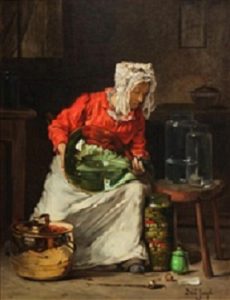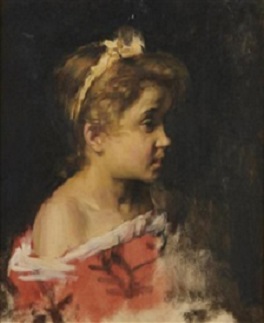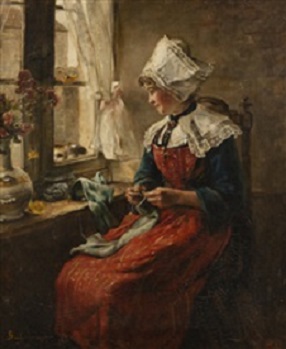lWho was Joseph Bail?
Joseph Claude Bail (1862-1912) was a French artist born in Limonest in the Rhone region of France. His work reflected the values of former times that showed devotion to the past era rather than changing their art form from modernization.
Obstructions
Joseph Bail was born during extreme controversial period in the Persian art works where Salon juries rejected most of the proposals of progressive artistic work. It was the duration whereon one hand printmaking was making its establishment as the true form of art while on the other hand the Barbizon painters developed the art form of modern countryside challenging the old traditions of historical landscapes. Art based on Realism was old enough that all artist focused on nineteenth century modern art, but Joseph Bail was not one of this artist .He was interested and believed in Realistic art and traditional values that created more difficulties for him to get launch and get success.
Early Life of Joseph Claude Bail
The artistic nature of Joseph Bail was from his father Jean Antoine Bail who himself was a trained genre painter. He inspires Joseph to focus on depicting scenes that are from daily life like that of Dutch Masters. Both Joseph Bail and his brother Franck Bail, followed the footsteps of his father and pursued the passion of artist although having deep interest in other subjects that were upcoming during that time. Jean, Franck, Joseph all three were artist, the Bail family was one of the few clique that represented realistic tradition of art in the late nineteenth century.
They didn’t jumped in to the running era of modern distortion form of art but looked backward into the past and devoted their art career to values and traditions of former times. In the vicinity of industrialization and modernization their paintings depicted the past life of France and was success to attract audience in Victorian patron.
At the beginning of his training period, Josephs father imparted in him due respect for eighteenth century artist like Chardin and Dutch Master and also aided him to observe their work at Louvre. After his basic training from his father, Bail started his training between 1879 and 1880 under Jean –Leon Gerome, a well-established painter and teacher of that time. Despite his training, Bail could not succeed in getting himself listed in Salons catalogue. This may be due to the reason that Gerome’s choice of subject differed vastly from Bails Subject in which he wanted to make career or from that which his father taught him these years
Despite these differences, Bail appeared at Salon of 1878 along with his father and brother depicting “Nature Morte” which means Still Life. The concept f still life in eighteenth century was inaugurated by Jean Chardin and it still continues to be one of the major subject for the interest of artist. These type of painting shows important element of work, and still life arrangements within the picture are shown by many genre scenes.
Appraisal of Joseph Claude Bail
Henry Marcel commented that Bail took inspiration from homely objects .He developed his craftsmanship rising from his cellars, variety of kitchens to bedrooms and living rooms .He gratified himself from daily objects, and embraced himself t future rays of success.
Dictionnaire Nationale des Contemporains wrote that Joseph Bail painted in most divergent fashion. All of his paintings are provocative but the one that are outstanding were his interior scenes, perfectly lit and very well synchronized, where transparency of glass and shine of copper added noted to its perfection.
Emmanuel Bénézit in Dictionnaire Critique et Documentaire des Peintres, Sculpteurs confined that Bail had excellent elegance in the composition of painting and treats them very skillfully. He creates very lively painting because of radiant shine to some brilliant points and direct projection of the daylight. He has perfect technique of coloring just the right way. He was rare artist of tradition of his time.
In A Handbook of Modern French Painting D. Cady Eaton declared before his death that, Bail was very popular and lucrative painter. He further added that his pictures are not ambitious or startling rather they give homelike and comfortable feeling.
Art Gallery
He continued the tradition of Theodule Ribot by combining his modelling and placement of object with his engrossment in human form and emotions, depicting various daily activities of household as completed by maids and cooks. Some of them were children’s in their youth. Bail illustrated the integrity of middle class life and their traditions and he became best artist for painting those maids and cooks. He depicted these figures with their freedom and humorous expression in his painting rather than describing the pain and difficulties of their labor. Some of his paintings are
- La Menagere

- Potrait de fillette de profil

- Young Girl Sewing near the window

Honors received by Joseph Claude Bail
Bail was regular contributor to the Salon, but by the end of his career he exempted himself from submitting his work for the approval of jury as he was already a success material for all. During his journey he received following honors
- Honorable Mention in 1885
- Third Class Medal in 1886
- Second Class Medal in 1887
- Silver Medal in 1889 Exposition Universelle
- Gold Medal in 1900 Exposition Universelle
- Medal of Honor in 1902
He was also designated as “Chevalier de la Légion d’Honneur “in 1900. He also became a member of the Société des Artistes Français. He died November 26, 1921.